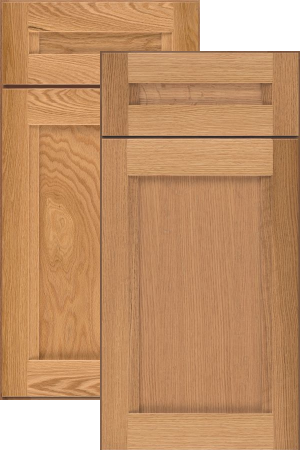With their towering, majestic shapes, Oak trees are symbols of strength, endurance, and beauty. So, it’s no surprise that sturdiness and a grand visual character are key Oak wood properties. Beyond being a preferred choice for kitchen and bath cabinets, Oak is a prized species for many uses. For hardwood flooring, Oak is a durable, stable, and handsome option. Wines and spirits are often aged in barrels made of Oak because it has good moisture resistance. Even the desk in the White House Oval Office is made of Oak.

Two KraftMaid cabinet doors in natural finish showing the visual differences between Oak and Quartersawn Oak species.
With KraftMaid®, you have two forms of Oak to choose from – Oak and Quartersawn Oak.
Oak is one of the most recognizable wood species because of its prominent, wavy grain pattern. The woodgrain varies from straight, thin lines to wide, sweeping “cathedral” patterns. Oak also has an open grain, meaning the irregular visual grain pattern is matched by a coarse texture – you can feel the differences in the grain as well as see them.
Quartersawn Oak is created by milling lumber at a different angle than plain-sawn Oak. This results in a tighter, straighter grain pattern compared to Oak. Plus, quartersawing often reveals naturally occurring ray flecks – also called figuring – that add distinction. (While the results are stunning, this technique also yields less wood from each log, making Quartersawn Oak more expensive than Oak.)
Our cabinets feature Red Oak, which ranges in color from pale, creamy shades to medium browns with reddish casts. The differences between colors can be distinct. It’s also possible to find a few darker mineral streaks mixed in
Oak is considered a North American hardwood based on the distinction of it being a deciduous, flowering tree versus a needle-bearing softwood conifer.
When most people hear the term hardwood, they think of strength and durability – the literal hardness of the wood – not the biological type of tree. Look to the Janka Hardness Rating to measure how well a wood species can stand up to dings and dents of real life.
Here’s how Red Oak compares to a few other common wood species you might find in and around your home. The higher the Janka rating number, the harder the wood:
| SPECIES | CLASSIFICATION | JANKA HARDNESS RATING |
|---|---|---|
| Red Mahogany | Hardwood | 2,697 |
| Teak | Hardwood | 2,330 |
| Hickory | Hardwood | 1,820 |
| Hard Maple | Hardwood | 1,450 |
| Red Oak | Hardwood | 1,290 |
| Cherry | Hardwood | 995 |
| Southern Yellow Pine | Softwood | 870 |
| Alder | Hardwood | 590 |
| Eastern White Pine | Softwood | 380 |
| Balsa | Hardwood | 70 |
Red Oak has a Janka Hardness Rating of 1,290, putting it in the middle of commonly used hardwoods. In fact, it is considered as the industry benchmark in North America for comparing the relative hardness of native species. In other words, Red Oak sets the standard for resisting scratches and dents. Plus, Oak is among the most stable woods on the market. With a little TLC, your Oak cabinets will last a lifetime.